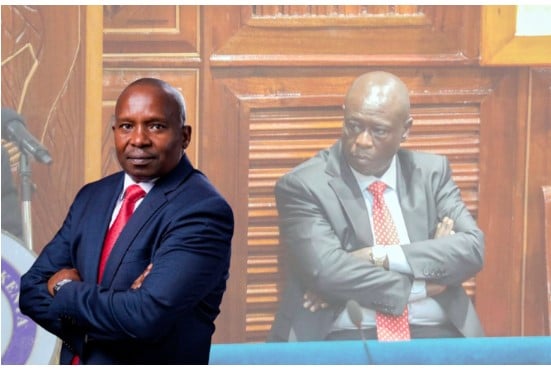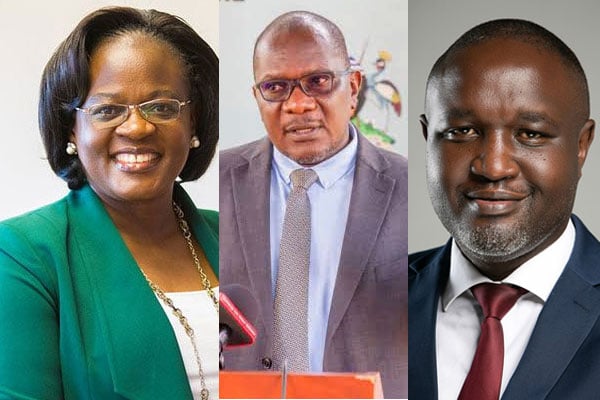Prime
How Luwalira found his purpose at Namirembe

Bishop Wilberforce Kityo Luwalira of Namirembe Diocese.
What you need to know:
- In the third instalment of our Salt of the Earth series, Derrick Kiyonga takes stock of Wilberforce Kityo Luwalira’s tenure as bishop of Namirembe Diocese ahead of his departure in December.
It was on a Sunday in May 2009 when Rev Can Wilberforce Kityo Luwalira was handed the reformation study Bible, a pastoral rod, and the bishopric ring before taking his seat of Episcopal authority at Namirembe Cathedral.
The connotation of all this was that Luwalira had stopped being a Reverend Canon as he had been promoted to the rank of Right Reverend. This meant he became Bishop of the 117-year-old Namirembe Diocese, the hub of Anglicanism in Uganda.
Only 49 then, Luwalira was the youngest prelate to become the bishop of Namirembe. He walked a path that four behemoths had taken before. One of them was Bishop Dunstan Nsubuga, who became the diocese’s first Muganda bishop, having taken the reins of the diocese from Bishop Leslie Brown, a Briton, in 1965.
The first challenge that Nsubuga faced was the battle over the place of Namirembe Cathedral and Diocese in post-independence Uganda. The Church of Uganda (CoU) went into crisis in 1965 when Bishop Erica Sabiti, a Munyankore, edged out Nsubuga to be the first black Archbishop of the Church of Uganda.
“The Church leadership was divided along the Buganda/rest-of-Uganda line. Sabiti’s election had delineated the issue that was to dominate the entire period of his archiepiscopal leadership; the place of the Church in Buganda in the whole Church of Uganda,” says retired Bishop David Zac Niringiye.
Although two Buganda dioceses—Namirembe and West Buganda—had considered seceding, the impasse was resolved in 1972 when the Kampala Diocese, headed by the Archbishop, was carved out of Namirembe Diocese.
“Within the church, the bitter dispute between Bishop Nsubuga and Archbishop Sabiti had greatly compromised the former. Besides, a commission of inquiry appointed in 1972 by [President Idi] Amin and headed by a High Court judge to investigate the administration of church properties (particularly land) had reported irregularities in the Namirembe Diocese. This clearly made Nsubuga’s second attempt at the archbishopric untenable,” writes Prof Akiiki Mujaju in his book titled The Political Crisis of Church Institution in Uganda.
The 1966 crisis where Kabaka Mutesa fled into exile after government troops descended on his Mengo palace at the behest of Milton Obote further complicated things.
“During the early months of the state of emergency in Buganda, several churches did not hold Sunday worship services, as there was fear of the security forces that had been dispatched all over Buganda. But wherever the Christians were, they prayed for the safety and return of their Kabaka,” Bishop Niringiye says.
Nsubuga also superintended over the Namirembe Diocese when Yoweri Museveni’s National Resistance Army (NRA) was waging war in the Luweero jungles. In 2012, he was awarded the Nalubaale Medal (which was never claimed by his family members) on account of supporting the rebel outfit.
Charismatic Kauma
Before the NRA’s takeover, Bishop Nsubuga would make way for Bishop Misaeri Kauma in 1984. Four years later, Kauma ordained Luwalira, Stephen Kaziimba Mugalu, William Ssebaggala, and Henry Katumba Tamale as priests. All four later became Bishops, with Kaziimba currently the Archbishop of the Church of Uganda.
“Bishop loved me so much. He told me I would be the Chaplain. Sometimes it’s me who chauffeured him. He also entrusted me with the pastoral rod. I would handle the pastoral rod on behalf of the bishop,” Luwalira said during Kauma’s memorial service at Namirembe Cathedral in 2017.
Kauma lasted only 10 years as the Namirembe bishop. He took over the role at a difficult time when the scourge of HIV/Aids was noticeable in Uganda after the first cases were identified in Rakai District. Kauma not only prayed for HIV/Aids patients, but was the first Anglican prelate to accept condoms as part of the Abstinence, Be faithful, and use a Condom (ABC) strategy.
“If you become a fool by indulging in fornication and promiscuity, never be [so] stupid [as] to refrain from using a condom,” Bishop Kauma said while welcoming artiste Philly Bongole Lutaaya, the first Ugandan celebrity to openly declare his HIV status in Uganda.
In 1995, after Kauma had retired as Bishop of Namirembe, Mr Museveni appointed him commissioner of the Uganda Aids Commission.
Kauma was succeeded by Samuel Balagadde Sekadde, a prelate with an imposing personality, who led the diocese for 15 years amid challenges of poverty, HIV/ Aids, and child sacrifice. Sekadde, who hailed from Luweero, at one point championed compensation claims by Luweero triangle dwellers, who bore the brunt of the Ugandan Bush War.
“Although our home was destroyed, I’m not demanding anything,” Ssekadde used to say. “I ask the president to meet our people and see how best they can be helped.”
Although he was famed for his charisma as his stewardship of the diocese was winding down, Bishop Sekadde was accused of selling or illegally leasing church land. Although he protested his innocence, the stain never went away. To compound matters, he was also accused of clinging onto power.

Bishop Luwalira and the wife during the interview before their silver jubilee celebrations on Tuesday. PHOTO BY ABUBAKER LUBOWA
On February 21, 2009, the House of Bishops elected Luwalira as Sekadde’s replacement. Luwalira beat his singular rival, then Namirembe cathedral Dean, Rev Can Augustine Magala Musiwuufu, after a contested vetting process. Back then, Rev Can Nelson Kaweesa, the Diocesan Secretary, was believed to be in pole position to succeed Sekadde. Kaweesa’s name didn’t make it to the final list though.
In choosing Luwalira, the Anglican Church had gone from a larger-than-life, if not flamboyant character, to a warm and trifling-mannered bishop. With hindsight, the choice was hardly surprising as Luwalira had always been seen as Sekadde’s protégé. He also won over the hearts and souls of many young Christians whom he used to counsel when he was Vicar of Namirembe Cathedral.
“He was always soft-spoken and approached things in a calm manner,” a warden at Namirembe cathedral, who preferred anonymity to speak freely, said of Luwalira’s eight-year stint as Vicar (in charge of policy).
Luwalira’s meteoric rise wasn’t a bed of roses though. In 1982, when the Bush War was in its infancy, Luwalira, born in Kiwenda, Wakiso District to Eriazaali Kityo and Gertrude Nantume, was posted as priest to Namulonge, Wakiso. It didn’t take long for all hell to break loose.
“My days as a priest at Namulonge were characterised by unrest in the country. One night, in 1982, I was alone in the house when I heard a lot of wailing voices. I didn’t know whether the army detach nearby had been attacked,” Luwalira recalled, adding, “I heard people walking towards the church and before long they were closing in on my house. They shook the door but somehow failed to enter. I was scared to death. I found out the next morning that many people had been killed that night and I knew I had survived by a whisker.”
Things didn’t improve when he was the head of students at Namugongo Seminary in 1985. In fact, the principal and others were killed during one raid.
When Luwalira took over as Namirembe bishop, the relationship between the Buganda Kingdom and the central government was at an all-time low in the wake of the September 2009 Buganda riots. Many people were killed during the riots after Kabaka Ronald Muwenda Mutebi was blocked from touring Bugerere County.
While at the helm of Namirembe, Luwalira has juggled preaching the gospel with having a political voice.
“We have had scenarios where votes cast are more than the voters on the voters register. Then you would wonder why they went to the bush,” Luwalira said in 2021, adding, “We have been seeing and hearing of people disappearing. One would wonder why people are killed. One would wonder why the situation is getting out of hand.”
Away from politics, Luwalira from the get-go made clear his intention to renovate St Paul Cathedral, commonly known as Namirembe. Uganda’s oldest cathedral was leaking and embarrassingly out of shape. On Luwalira’s watch, Namirembe Cathedral has got its shine back, thanks to a fundraising campaign that yielded Shs3 billion.
Namirembe scorecard
Being the Bishop of Namirembe entails that you supervise more than 342 local churches, and eight archdeaconries, including Masulita, Entebbe, Gayaza, Kazo, Lutikko, Luzira, Mengo, and Nateete. You also serve as the board chairperson of several educational institutions, including Mengo Senior School, King’s College Budo, Gayaza High School, inter-alia. No wonder Luwalira prides in the work he has done in education institutions such as Buloba Teachers College, where several blocks were constructed during his tenure.
“We had to go and do some good work on the buildings and whatever was there,” said Luwalira, who has also used the Church’s vast swathes of land to spearhead many commercial agricultural projects in Namayumba and Masuliita, Wakiso District.
Perhaps the darkest moment of Bishop Luwalira’s tenure was in 2020 when St Peter’s Church in Ndeeba, a Kampala suburb, was demolished. The High Court ruled the Trustees of the Church of Uganda had fraudulently acquired the land where the church sat. With some of the clergy found culpable of demolition of the church, Namirembe Diocese was squarely put in the limelight.
“As human beings, we make mistakes because of selfishness and other reasons but I know it’s Christ who redeems all of us,” Bishop Luwalira explained.
As retirement beckons, one of the things that the Church of Uganda is currently struggling with is homosexuality. Earlier this year, the General Synod of the Church of England, the mother church of Anglicanism, permitted clergy to preside at blessings of same-sex unions. It also approved supplemental prayers and liturgies for such occasions. This prompted a scathing response from the Anglican Church in Uganda led by Archbishop Kaziimba.
“We all know the story of the Uganda Martyrs, how they refused to engage in homosexual sex with their leaders. They stood firm in their Christian faith and were martyred for it. We cannot betray them or our Lord Jesus Christ. We will not betray the Word of God or His ways,” Archbishop Kaziimba said.
Bishop Luwalira said: “Globally, we have a challenge of immorality and promoting even what a young child would see as a problem. You have heard of homosexuality, and lesbianism, and yet people are presenting it as the rule of the day.”
Luwalira at a glance
1959: Born in Kiwenda, Wakiso District
1966-74: Studied at Namulonge Primary School
1967: Baptised by Can Henry Lugolobi.
1976: Accepted Jesus as his personal saviour
1978: Obtained UCE certificate at Kololo Secondary School
1979: Offered the job of stockman at Nakyesasa Animal Husbandry Unit in Namulonge
1982: Trained as church minister at Namulonge by Rev John William Kanakulya
1984-86: Joined Namugongo Martyrs Seminary
1986: Appointed deacon at Namirembe and posted to Kabowa
1990: Married Faith Nakitende on September 2. She was a teacher at Gayaza High School.
1990-93: Went to Bishop Tucker Theological College Mukono to study a diploma in theology.
1997-2000: Studied degree in Theology
2000: Posted to Mutundwe
2001-09: Vicar of Namirembe Cathedral.
2009-2023: Namirembe Bishop.
Next week, the fourth instalment of Salt of the Earth will look at the contenders looking to slip into Bishop Luwalira’s shoes at Namirembe and everything in between.





